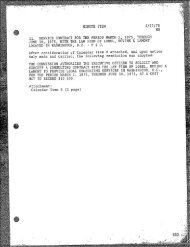Mooring Loads Due to Parallel Passing Ships - State Lands ...
Mooring Loads Due to Parallel Passing Ships - State Lands ...
Mooring Loads Due to Parallel Passing Ships - State Lands ...
You also want an ePaper? Increase the reach of your titles
YUMPU automatically turns print PDFs into web optimized ePapers that Google loves.
The second type of predictive method, empirical equations or simplified<br />
spreadsheets, are presently used within both NAVFAC and the California <strong>State</strong> <strong>Lands</strong><br />
Commission and are therefore the focus of the present study. As noted, two simplified<br />
predictive methods are presently available. One method, developed by Seelig (2001),<br />
is a spreadsheet called PASS-MOOR that is based on theoretical predictions of Wang<br />
(1975). Wang’s method gives mooring loads for deep water where the vessel draft is<br />
small compared <strong>to</strong> the water depth. Seelig then modified Wang’s theoretical solution by<br />
including empirical correction fac<strong>to</strong>rs <strong>to</strong> account for finite depth (small underkeel<br />
clearance). These correction fac<strong>to</strong>rs were based on analysis of labora<strong>to</strong>ry test data as<br />
reported by Remery (1974) and Muga and Fang (1975). The second predictive method,<br />
developed by Flory (2002), consists of empirical equations for surge force, sway force,<br />
and yaw moment. These were derived from the Remery (1974) data, which are<br />
applicable in shallow water. Flory then developed correction fac<strong>to</strong>rs for other values of<br />
underkeel clearance based on the test data of Muga and Fang (1975).<br />
As the preceding paragraph indicates, both of the simplified prediction methods<br />
use empirical results from the same limited labora<strong>to</strong>ry tests conducted by Remery<br />
(1974) and Muga and Fang (1975). Interestingly, both sets of data were obtained from<br />
the same labora<strong>to</strong>ry facility, the Netherlands Ship Model Basin, and both used similar<br />
scaled models of large oil tankers. Given the limited number of tests performed, and<br />
the fact that both predictive methods have an empirical basis in the same data sets, it<br />
is not clear how well these methods apply outside of the range of conditions tested.<br />
DESCRIPTION OF PROJECT<br />
The present study addresses these issues through additional scale model tests,<br />
through analysis of the existing predictive methods <strong>to</strong> assess their validity in predicting<br />
the measured mooring loads, and through development of new empirical equations <strong>to</strong><br />
predict mooring loads.<br />
The first goal of this study was <strong>to</strong> expand the database for mooring loads<br />
caused by passing ships, and 144 model tests were then carried out at the U.S. Naval<br />
Academy. These tests were conducted using generic “Series 60” hull forms<br />
representative of commercial vessels with high block coefficients. Tests were<br />
conducted for the case in which the passing ship travels in a direction parallel <strong>to</strong> the<br />
moored ship. Variables in the test plan then included the passing ship draft, the water<br />
depth, the passing ship speed, and the separation distance between the ships.<br />
Measurements included the time-his<strong>to</strong>ries of the surge force, sway force, and yaw<br />
moment. Peak values of all three parameters were then extracted for further analysis.<br />
The second goal of this study was <strong>to</strong> develop a set of empirical equations for the<br />
peak surge force, sway force, and yaw moment from the new data. These equations<br />
are in some ways similar <strong>to</strong> those developed by Flory (2002) but are based on the new<br />
model data rather than on the earlier test data of Remery (1974). These equations are<br />
given in dimensionless form and allow prediction of the maximum force and moments<br />
based on basic parameters such as the draft-<strong>to</strong>-depth ratio, the relative separation<br />
NFESC TR-6056-OCN<br />
2

















